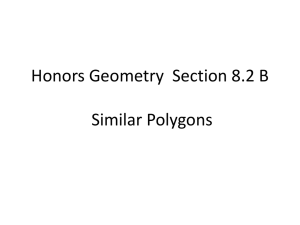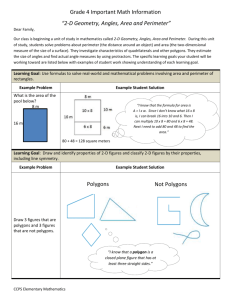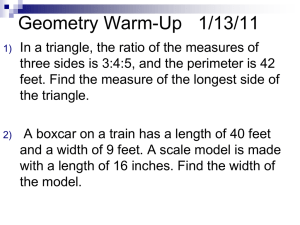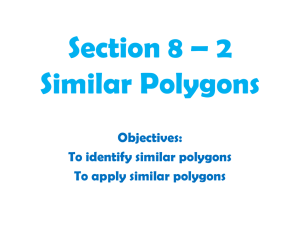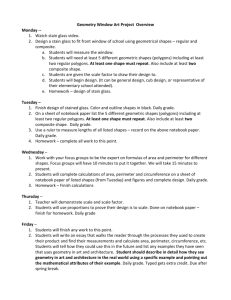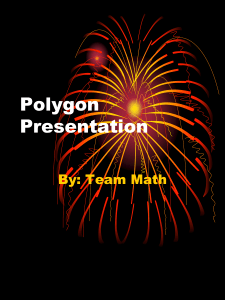Mathematics Unit Group Project: Picturing Polygons
advertisement
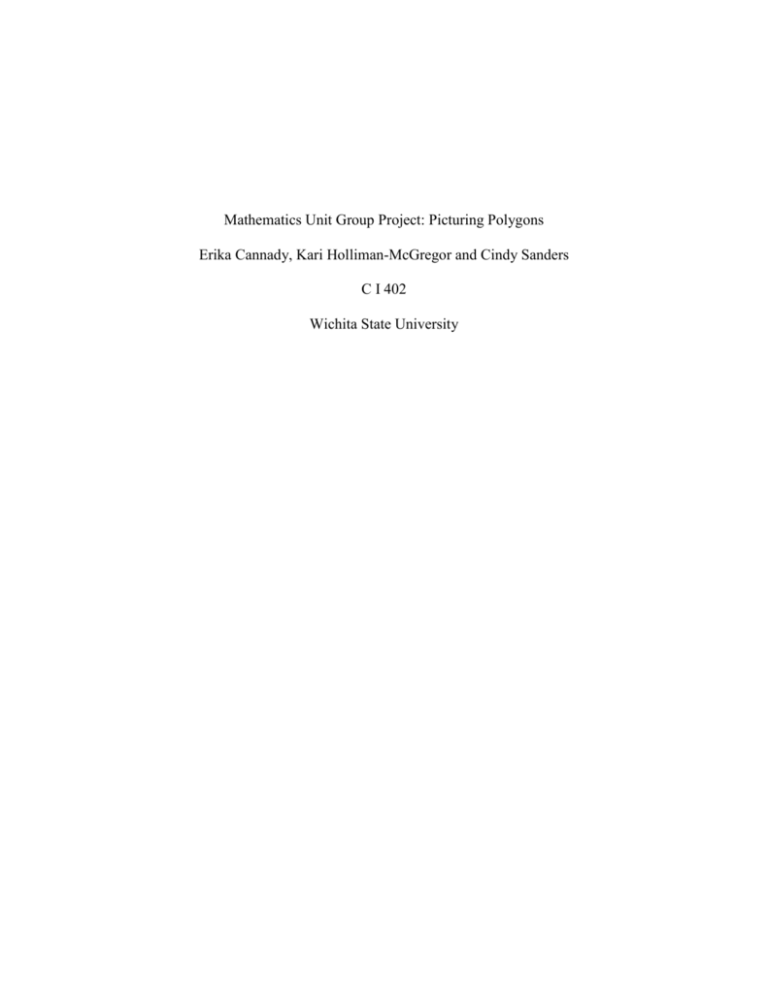
Mathematics Unit Group Project: Picturing Polygons Erika Cannady, Kari Holliman-McGregor and Cindy Sanders C I 402 Wichita State University Unit Theme: Picturing Polygons Grade Level: 5th Standards: NCTM Geometry Standards: Analyze characteristics and properties of two- and three-dimensional geometric shapes and develop mathematical arguments about geometric relationships o Identify, compare, and analyze attributes of two- and threedimensional shapes and develop vocabulary to describe the attributes o Explore congruence and similarity o Make and test conjectures about geometric properties and relationships and develop logical arguments to justify conclusions Use visualization, spatial reasoning, and geometric modeling to solve problems o Build and draw geometric shapes o Recognize geometric ideas and relationships and apply them to other disciplines and to problems that arise in the classroom or in everyday life. NCTM Communication Standard Communicate their mathematical thinking coherently and clearly to peers, teachers, and others Analyze and evaluate the mathematical thinking and strategies of others NCTM Problem Solving Standards Build new mathematical knowledge through problem solving Apply and adapt a variety of appropriate strategies to solve problems Monitor and reflect on the process of mathematical problem solving NCTM Reasoning and Proof Standards Make and investigate mathematical conjectures Develop and evaluate mathematical arguments and proofs NCTM Representations Standards Create and use representations to organize, record, and communicate mathematical ideas Use representations to model and interpret physical, social and mathematical phenomena Vocabulary: Polygon, Tangram, Triangle, Square, Rectangle, Hexagon, Similar Integration Ideas: Art: “Picasso’s Polygons” handout Math: fractions with different polygons Art: Use a triangle or quadrilateral and make tessellations, you can discuss the properties of each as you change, flip, and slide the shapes Language Arts: Make a children’s story about a triangle or quadrilateral. The students will have to include the properties that define each in a fun way with illustrations Explanation of How Each Lesson Fits in the Unit: What Can We Do With Polygons? Lesson: This lesson acts as an introduction to the unit Picturing Polygons. Students will review the basics of a polygon, classify polygons from non-polygons, and use polygons as tangrams. This lesson will assess the students’ prior knowledge, as well as, increase their knowledge on polygons, which will prepare them for our next lesson in the unit, Sorting Polygons. What Makes a Polygon a Polygon? Lesson: This lesson allows student’s to use previous knowledge from “What Can We Do With Polygons?” to determine the characteristics that define a triangle and quadrilateral. They have to reason and communicate with their peers to proof that the definition of their triangle and quadrilateral is correct. They are also using problem solving and manipulatives to decide what type of polygon they created on the geoboard. This will prepare them for comparing similar shapes with polygons. Building Similar Shapes Lesson: This lesson is the last lesson in the Picturing Polygons Math Unit. It allows students to build on their prior knowledge about polygons to learn the mathematical meaning of similarity as they look as similar polygons. The students will build larger and larger polygons using similar shapes of the starting shape. They will also make generalizations about what happens to the area of a shape when the lengths of all its sides are doubled and tripled. Unit Reflection: This unit allows students to explore polygons using different process standards and manipulatives. Students are able to create polygons and discuss the properties that define each shape. This will help students to identify and connect the patterns and relationships between the sides and area of polygons, as they make similar shapes. The students will have to reason and communicate with their peers to determine what characteristics define a polygon and use this information to evaluate similar shapes. WHAT CAN WE DO WITH POLYGONS? – LESSON PLAN Name: Erika Cannady Date of Lesson: September 16, 2004 Subject Area/Topic: Mathematics/Polygons, Tangrams Grade Level: 5th Grade Standards: NCTM Geometry Standard o Analyze characteristics and properties of two and three dimensional geometric shapes and develop mathematical arguments about geometric relationships Identify, compare, and analyze attributes of two and three= dimensional shapes and develop vocabulary to describe the attributes. o Use visualization, spatial reasoning, and geometric modeling to solve problems Use geometric models to solve problems in other areas of mathematics NCTM Communication Standard – Communicate their mathematical thinking coherently and clearly to peers, teachers, and others NCTM Problem Solving Standard o Build new mathematical knowledge through problem solving o Apply and adapt a variety of appropriate strategies to solve problems o Monitor and reflect on the process of mathematical problem solving Outcomes/Objectives: The main idea that students will understand is that polygons can be used to create different shapes. The student will distinguish between polygons and shapes that are not polygons. The student will develop an understanding that polygons can be put together to create different shapes. Vocabulary: polygon, tangram Materials/Technology: Scissors, tangram handout, expand tangram handout Procedure: Engage: Explore: Review what a polygon is by reading over facts on the chart and completing “Is it a Polygon?” handout as a class. Ask “What can we do with polygons?” Hand out materials. Students work to make the large shape using the polygon pieces. Possible teacher questions: o What else could you try? o Can you find another arrangement that works? Explain: Expand: Students will show what arrangements they found that worked. Possible teacher questions: o Can you think of any hints you could give to someone who isn’t figuring it out. Students will be given a sheet of new polygons. They will design a shape of their own using polygons. Students will share what they come up with. Evaluate: Each student will make a sketch of how they accomplished two of the tangram pictures. Expand 2: Students will be given the handout Picasso’s Polygons. Adaptations/Modifications: Students can work in groups to figure out the tangrams. References: Akers, J., Clements, D., Murray, M., Tierney, C., & Samara, J. (1998). 2-D geometry: picturing polygons. White Plains, NY: Dale Seymour Publications, 2-8, 162-163, 167. “Tangrams.” Available: http://www.tangrams.ca [September 19, 2004]. “Tangram Puzzles.” Available: http://www.funorama.com September 19, 2004]. The National Council of Teachers of Mathematics. (2000). Principles and standards for school mathematics. Virginia: The National Council of Teachers of Mathematics, Inc., 164, 402 Reflection: This lesson is appropriate for 5th graders because the material is familiar to them. They have already learned what a polygon is, so they are now increasing their knowledge by doing a hands-on activity. Ideas for Integration: Art- “Picasso’s Polygons” handout Math- fractions with different polygons. Student Handouts/ Worksheets Will Go Here WHAT MAKES A POLYGON A POLYGON? Kari Holliman Math, Polygons Grade Level: 5 Estimated Length: 1-1 ½ Hours September 17, 2004 Standards: NCTM StandardsGeometry Make and test conjectures about geometric properties and relationships and develop logical arguments to justify conclusions Recognize geometric ideas and relationships and apply them to other disciplines and to problems that arise in the classroom or in everyday life. Explore congruence and similarity Reasoning and Proof Make and investigate mathematical conjectures Develop and evaluate mathematical arguments and proofs Communication Communicate their mathematical thinking coherently and clearly to peers, teachers, and others Analyze and evaluate the mathematical thinking and strategies of others Outcomes/Objectives: 1. Students will understand what the characteristics of a triangle and quadrilateral are. They will know what is required for a shape to be a rectangle and square. 2. Students will o Explore attributes of triangles and quadrilaterals o Classify triangles and quadrilaterals Vocabulary: Polygon, Triangle, Square, Rectangle Materials: Geoboard Rubber bands Pictures of 3 sided Polygons (given to each student) Pictures of 4 sided Polygons (given to each student) “Polygons on the Geoboard” handout “Is Every Three-Sided Polygon a Triangle” handout “Is Every Square a Rectangle, Is Every Rectangle a Square” handout Procedure 1. ENGAGE a. Every student will be given a Geoboard and the handout Polygons on the Geoboard, they will work together will a partner to complete this activity (CONCRETE) b. The students will make different polygons according to the characteristics given from the handout c. After everyone has completed, review the different types of polygons “What are some ways we can use to identify the type of polygon?” 2. EXPLORE a. Give each student about 3-4 pictures of three sided polygons and have them examine them (PICTORIAL) b. “What do we call three sided polygons?” c. “Are all of these three-sided figures triangles? Why or why not?” d. The students will work in small groups to discover if all three sided figures are triangles-(use handout to record their data) They will also discuss in their groups the different categories of triangles 3. EXPLAIN a. The students will report to the class their finding of three sided figures and triangles b. They will get back into their groups and figure out the different characteristics of All Triangles and Some Triangles-(they will record their results on a chart) c. When the students have ran out of ideas, post their lists, the students will explain their results d. Tell them that you will continue to add to the list throughout the unit as they come up with more ideas 4. EXPAND a. Give the students pictures of four-sided shapes b. “What are these shapes?” c. “Do all quadrilaterals have four sides? What else do all quadrilaterals have to have? d. Record the data of All Quadrilaterals and Some Quadrilaterals e. Possible Teacher Questions “What are some of the differences among quadrilaterals?” “What is true of the sides of some quadrilaterals?” “What kinds of angles do some quadrilaterals have?” 5. EVALUATE a. Now that you have discussed different characteristics of triangles and quadrilaterals the students will complete the handout “Is Every Square a Rectangle, Is Every Rectangle a Square” b. Have the students communicate their results and discuss when every one is completed 6. EXPAND (2) Students will complete “Can You Make These Triangles” handout References National Council of Teachers of Mathematics (2000). Principles and standards for school mathematics. Portland, OR: Graphic Arts Center. Akers, J., Clements, D., Murray, M., Tiernay, C. & Samara, J. (1998). 2-D geometry: Picturing polygons. White Plains, NY: Dale Seymour Publications, 31-45, 169-170, 172 Reflection This lesson is appropriate for fifth graders because they have to use prior knowledge of polygons to determine the characteristics that define a triangle and quadrilateral. They have to reason and communicate with their peers to proof that the definition of their triangle and quadrilateral is correct. They also are using problem solving and manipulatives to decide what type of polygon they created on a geoboard. Ideas for Integration Art: Take a triangle or quadrilateral and make a tessellation Language Arts: Make a children’s story about a triangle or quadrilateral. The students will have to include the properties that define each in a fun way with illustrations. Student Handouts/ Worksheets Will Go Here Building Similar Shapes Name: Cindy Sanders Date: September 28, 2004 Subjects: Mathematics Grade Level: 5th Standards: National Mathematics Standards: Analyze characteristics and properties of two- and three-dimensional geometric shapes and develop mathematical arguments about geometric relationships o Identify, compare, and analyze attributes of two- and threedimensional shapes and develop vocabulary to describe the attributes o Explore congruence and similarity Use visualization, spatial reasoning, and geometric modeling to solve problems o Build and draw geometric shapes Create and use representations to organize, record, and communicate mathematical ideas Use representations to model and interpret physical, social and mathematical phenomena Objectives: 1) Students will be able to explain the mathematical meaning of similarity. 2) Students will be able to create geometric patterns that grow in regular ways. Vocabulary: Materials: Polygon Hexagon Similar Overhead Projector Power Polygons Student Worksheets “Building Similar Shapes” and “Length of Sides Versus Area” (1 for each student) Transparency of Student Worksheet “Building Similar Shapes” Procedures: Engage: Have several pictures that have different shapes in them. Ask students to pick out similar shapes that appear in the pictures. Explore: Show three polygons of different sizes from the set of Power Polygons on the overhead. Ask students what is the same and what is different about the shapes (Students may notice that the shapes share the same size angles, the same number of sides, etc. Students may notice a general difference in size.). Introduce the term similar as a word to describe the shapes. Place a rectangle on the overhead. Tell the students that we want to make larger and larger that are similar to this one, using only rectangle pieces this size. Explain: Have a student come up and build one using rectangle pieces on the overhead. If the student builds a rectangle that is 2x2, ask if it is really similar to the first (It is.). Build a rectangle that is 2x3; ask if the third rectangle is similar to both the first and second rectangles (It’s not). Ask the students to explain their reasoning. Expand/Extend/Apply: Hand out the Building Similar Shapes worksheet. Explain that to the students that they will be building larger and larger similar shapers, just as they did with the rectangle in the explain phase. Put a transparency of the worksheet on the overhead projector and show them how to record the data needed using the rectangle from the explain phase. For each shape on the worksheet, students will consider that the smallest similar figure takes one piece (the shape itself). Each time the next larger shape is built they record how many pieces it took. Students may work together, but should each independently build the shapes. Warn students that the hexagons are more difficult and will require a different strategy than the rest of the figures. Give the students some time to work then call them together to compare notes. Ask them what happened when they built larger and larger shapes. Many will observe that the numbers were the same; some will notice that the numbers were square numbers. Have the students explain what happened when they tried to make a similar hexagon. Did their first attempt work? What shapes did they need to use? Evaluate: Informally observe the students during the building time and class discussion. Analyze the responses on students’ worksheet. Have students write a paragraph about what they learned and include examples from their task. Expand/Extend/Apply 2: Hand out the worksheet “Length of Sides Versus Area” for homework. Students’ work on this sheet will serve as a good checkpoint of their understanding of similarity and the relationship of area to perimeter in similar figures. Resources: National Council of Teachers of Mathematics (2000). Principles and standards for school mathematics. Reston, VA: Authors, 164 and 402. Akers, J., Clements, D., Murray, M., Tierney, C., & Samara, J. (1998). 2-D geometry: picturing polygons. White Plains, NY: Dale Seymour Publications, 93-99 & 189-190. Reflection: This lesson is a good way to explain similarity of shape for students because it gives the students visual as well as kinesthetic ways to learn the topic. It also allows for small group work therefore fostering a community of learners in the classroom. Ideas for Integration: Art: Have students make their own art piece using similar polygons like Picasso. Student Handouts/ Worksheets Will Go Here


